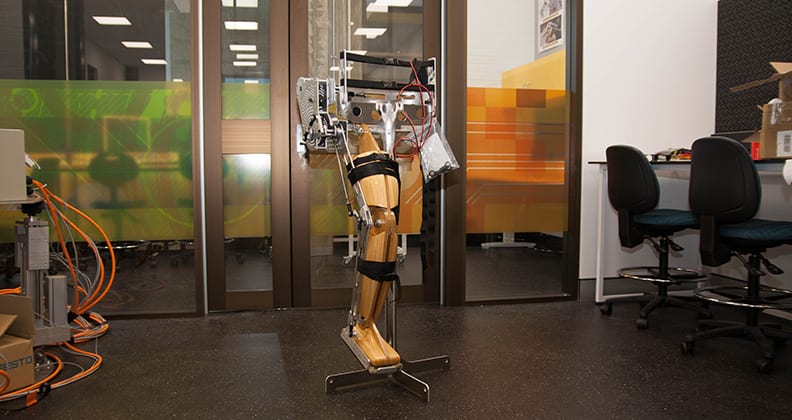When Head of Biorobotics Research Lab Dr Lei Cui invented an award-winning robotic finger orthosis last year, it was only the beginning of his vision to solve universal health problems using medical engineering.
Using similar engineering and design principles to his finger orthosis, Dr Cui has constructed a leg exoskeleton. The innovative, futuristic structure will be used to help people with spinal cord injuries to walk again.
The device will also help to make rehabilitation periods shorter and more effective. As the device is self-automated, it will also reduce the time patients spend seeing their doctor or physiotherapist for rehabilitation therapy. Other uses for the device include enabling search and rescue personnel to carry heavy loads when other transport methods are not available.
The leg exoskeleton is the first of its kind to require just one motor to control the hip, knee and ankle joints. Other types of walking-assistant devices use three motors for each of the joints, which affect their coordination. With Dr Cui’s prototype, the singular motor allows for more fluid coordination and creates a more natural walking gait.
“We will optimise the dimensional and structural parameters of the robot and adopt passive dynamic walking into the exoskeleton, producing an energy-efficient orthosis with a natural human gait,” says Dr Cui.
Though the exoskeleton looks like something you’d see in Blade Runner, it’s actually quite simple to use. A patient slots their leg in against the metal structure, while their foot stays off the ground by placing it on a small plate. Strapping goes around the patient’s leg and waist to hold them against the exoskeleton, and an on-off switch at the top of the exoskeleton, pre programmed by a computer, starts the leg moving and the patient’s leg follows.

The exoskeleton is still in early stages of development, but Dr Cui is enthusiastic to talk about the robot’s continuing advances, such as replacing its aluminium frame with carbon fibre, and using compliant joints at the hip, knee and ankle, which will better simulate the movement of joints in humans.
“The patient would ideally be able to use two exoskeletons, one for each leg,” says Dr Cui. “Currently the patient follows the gait of the robot, but in the future we can make the robot follow the human.”
Dr Cui is also working with Health Sciences researchers Susan Morris, Kevin Netto and Garry Allison to find out how the exoskeleton may affect a patient’s knee joint when using the device.
“The exoskeleton applies significant forces in the knee, and we don’t know how these forces will affect the knee joint,” he says.
“We’re developing an artificial knee to investigate this further.”
Dr Cui hopes the exoskeleton will be ready for patients to trial within one year.
“I would like to see the exoskeletons applied to people in need and improve their lives,” he says. “I think robotics is a fascinating area because I can use all the cutting edge technology and experience different areas of research. If I was just doing traditional research, I wouldn’t be able to learn about other things, but with robotics I get to combine and learn about a lot of different areas.”
Dr Cui will be taking his robots to Hale School in July, the Perth Science Festival on 13 to 14 August, and Scitech on 20–21 August to promote mechanical engineering to students, and encourage the public to discover the important roles robots increasingly play in our lives.
“Some people are afraid of a robot uprising and some people embrace the changes brought by robotics,” he says. “But robots are superior to humans in almost every aspect except creativity and adaptability. The future supermen/superwomen would consist of a human brain and robotic limbs and organs.”
Dr Cui welcomes any interest in his robots, and queries can be made to him directly at lei.cui@curtin.edu.au.
See the robotic devices at Open Day!
Dr Lei Cui will be demonstrating his finger orthosis and leg exoskeleton all day during Open Day on Sunday July 31. Find him at the Engineering Pavilion outside Building 215.



